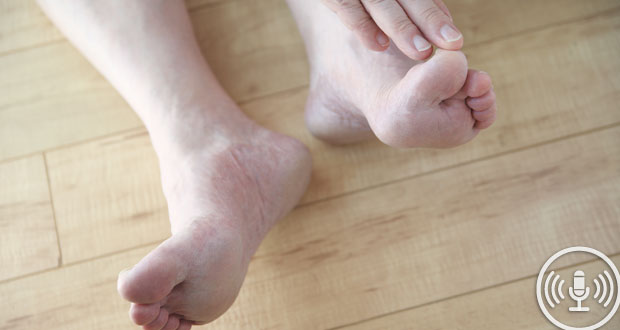Stronger toes could help keep older people on their feet, new research suggests.
Researchers at Victoria University have looked at the effect toe training can have on the incidence of falls in older people.
Karen Mickle, post-doctoral research fellow at Victoria University, said toe strength is a greater predictor of future falls than many other risk factors, adding people with weak toes and toe deformities are twice as likely to fall over.
Mickle previously found that toe strength is decreased in older adults by about 20-25 per cent compared to young adults.
“I had identified that reduced strength of the muscles that flex the toes is one of the strongest independent contributors to falls in older adults yet despite this evidence, no previous research has investigated whether a dedicated exercise program designed to strengthen the toe flexor muscles can reduce the rate of falling in older adults,” Mickle said.
She has since developed a series of exercises using resistance bands to restore strength and found that participants who attended classes three days a week for 12 weeks increased their toe strength by an average of 36 per cent.
The exercises were also found to help with the general health and function of ageing feet. Mickle said: “If normal foot function can be restored in individuals who suffer foot pathologies, we may reduce the risk of falls and foot pain and therefore improve independence and quality of life.”
In a separate piece of research from Victoria University, experts have been studying the benefits of exercise parks designed to improve the strength, flexibility and balance of older adults, and results from the first stage of the studying have been promising.
The research team used equipment manufactured by Finnish company Lappset and the park was installed at Villa Maria Catholic Homes’ St Bernadette aged-care home in Sunshine North.
Under the program, people exercise in pairs, using techniques designed to keep them active and help them cope easily with daily demands.
Among other equipment aimed at improving balance, the park includes a balance stool, suspended gangway and balance beam.
PhD researcher and exercise physiologist Myrla Sales said that participants in the 18-week exercise group experienced significant improvement in strength, balance and function. “We also concluded that using the park helps reduce the physiological risk of falling.”
Sales said the parks have the added benefit of getting people out in the fresh air and being social.
Associate professor Pazit Levinger said the findings indicate there is a case for a larger study. The researchers are now looking for partners for the design of the next trial. “We would like to get councils, community organisations and aged-care bodies involved and organise more sites,” Levinger said.
Click below to see older adults using the Senior Exercise Park.
Do you have an idea for a story?Email [email protected]
 Aged Care Insite Australia's number one aged care news source
Aged Care Insite Australia's number one aged care news source


great for a frequent fall friend 🙂
As a retired Victorian Maternal & Child Health Nurse, I read the article on the importance of our toes in contributing to our sense of balance with interest.
I am now 81 years of age, and in recent years have been fortunate enough to find an American make of shoe called Roamer made by SAS handcrafted comfort shoes, on sale at Gilmours Shoe shop in Glenhuntly Road, Glenhuntly. Victoria.
Finally I had a pair of shoes, which allowed me to grab the ground with my toes, and this reminded me of what I had been taught and witnessed, in my professional nursing role from 1968 until 2010 in MCH.
The human race gets on its feet, by the baby realising as it pulls itself to stand, and experiences sideway upright movements along the couch, that as maturation takes place and firstly with some support, the baby sets off on forward upright body movement, which includes grabbing the earth or floor with its toes, and other multiple muscular responses occurring, as the now toddler propels itself forward across the room.
In Victoria, many MCH Centres have Preschool Centres as neighbours, and I can remember the kindergarten teacher commenting on the importance of the type of shoes children needed when climbing on the play equipment.
From 1968 to 1975 I practised as a MCH nurse on a then Housing Commission Estate of 3,500 people, on the edge of a park where the local primary school children were brought down the hill for extra recreation space from their overcrowded inner Melbourne school.
In Winter time when the grass was still wet with the melting frost, I got used to see them falling over in their plastic shoes as the ran onto the grass in the park.
Good wishes for your research, which will benefit the ageing population.
Kathleen M Kehoe FACN[retired]